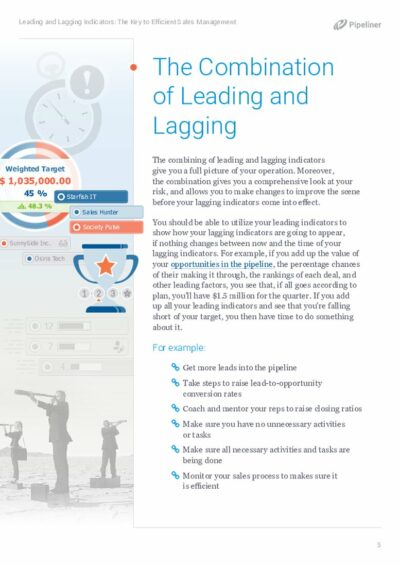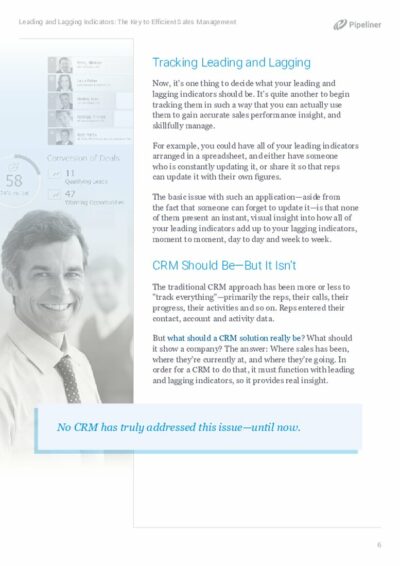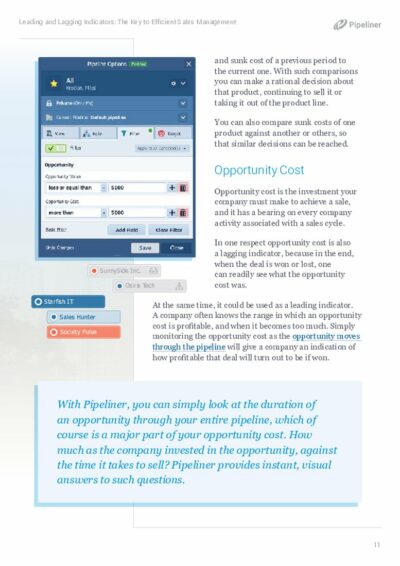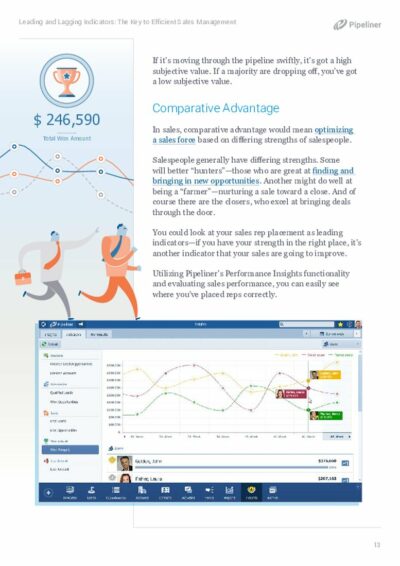
Leading and Lagging Indicators: The Key to Efficient Sales Management
Using the Right KPIs
The use of KPIs (Key Performance Indicators) is nothing new in business or sales. But if your KPIs are only of the lagging variety—the kind that shows the final results, such as gross sales, net revenueRevenue Revenue is the amount of money a business generates during a specific period such as a year or a quarter; also called sales., or products sold—you’re missing out on the entire field of prediction.
This white paper explains how sales management must be conducted through the right combination of leading and lagging indicators, so that management is precise, and catches errors or issues well before they affect your final results.
“KPIs are needed which help predict what those lagging indicators will be. These are called leading indicators, and they—along with their skillful combination with lagging indicators—are the subject of this white paper.”
 Nikolaus Kimla, CEO at Pipelinersales, Inc.
Nikolaus Kimla, CEO at Pipelinersales, Inc.The Combination of Leading and Lagging
The combining of leading and lagging indicators give you a full picture of your operation. Moreover, the combination gives you a comprehensive look at your risk, and allows you to make changes to improve the scene before your lagging indicators come into effect.
You should be able to utilize your leading indicators to show how your lagging indicators are going to appear, if nothing changes between now and the time of your lagging indicators. For example, if you add up the value of your opportunities in the pipelinePipeline Sales pipelineis a visual representation of the stage prospects are in the sales process., the percentage chances of their making it through, the rankings of each deal, and other leading factors, you see that, if all goes according to plan, you’ll have $1.5 million for the quarterQuarter Quarter is a three-month period in a company’s fiscal year commonly used to make comparative performance analyses, detect or forecast business trends, report earnings, and pay shareholder dividends.. If you add up all your leading indicators and see that you’re falling short of your target, you then have time to do something about it.
Lagging Indicators
Far too often, sales management is conducted strictly with lagging indicators. A clue to the problem with analyzing and managing only through lagging indicators is right there in the name: lagging. It means, “what has already happened.” By the time lagging indicators become clear, it is too late to change anything.
But in managing for the future, we need something that will show us how the activities we are engaging in now will impact our figures for the quarter or the year.
Leading Indicators
Which leads us to the other kind of KPIs: leading indicators. Leading indicators could be said to be the KPIs that come between the big lagging-indicator victories.
The Combination of Leading and Lagging
The combining of leading and lagging indicators give you a full picture of your operation. Moreover, the combination gives you a comprehensive look at your risk, and allows you to make changes to improve the scene before your lagging indicators come into effect.
You should be able to utilize your leading indicators to show how your lagging indicators are going to appear, if nothing changes between now and the time of your lagging indicators. For example, if you add up the value of your opportunities in the pipeline, the percentage chances of their making it through, the rankings of each deal, and other leading factors, you see that, if all goes according to plan, you’ll have $1.5 million for the quarter. If you add up all your leading indicators and see that you’re falling short of your target, you then have time to do something about it.
Additional Resources
This ebook is on the subject of “Win Together.” It falls under the same context as“win-to-win” described in my book Network Selling: Guarantee Success for the Digital Age. Today, this aspect of sales is more important than ever, and must also be part and parcel of CRM solutions.
“For some years I’ve been saying that, as a society, we’re in the midst of a transformation. Given what’s happened in the last couple of years, there’s no one left who is disagreeing with me! It’s become very obvious.”
 Nikolaus Kimla, CEO at Pipelinersales, Inc.
Nikolaus Kimla, CEO at Pipelinersales, Inc.A common term in sales today is EQ, which stands for “emotional I.Q.” It means the skill a salesperson has in reading emotions and utilizing them in sales. It means empathy and a number of other abilities. The short version is, it’s an I.Q. when it comes to emotions. But just as with our Network Selling model, E.Q. isn’t just for sales, either. It’s actually the missing factor in human interactions, for confrontation—a common “tool” in human interactions—doesn’t actually handle anything.
“You can have everything in life you want if you will just help enough other people get what they want.”
 Zig Ziglar
Zig Ziglar






